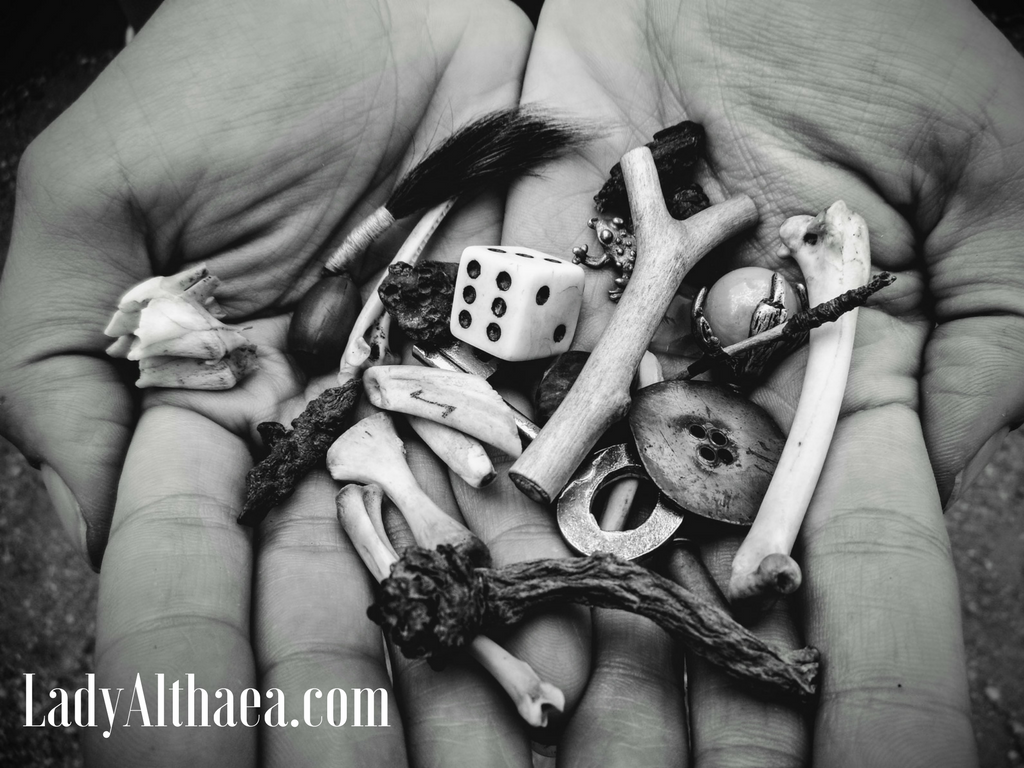|
Many religions feature an altar as part of their worship and Wicca is no different. But, despite what many would have you believe, an altar is more than just a place to store your magickal tools. An altar is a dedicated space to your interaction with your Gods, that is why when you are not actively using your altar it is more precisely called a *shrine. An altar is a sacred place where you call your Gods and sing Their praises, where you leave offerings for Them and ask for assistance. It is also a place where you do your magickal work, where you keep long-term spell items or charms worked at a distance for someone. Outside of specific Traditions of Wicca and other Neo-Pagan religions, there is no standard altar set up. That means if you are a solitary practitioner your altar can look however you desire -with whatever tools you want on it. There are, however, some general guidelines to the layout of an altar. 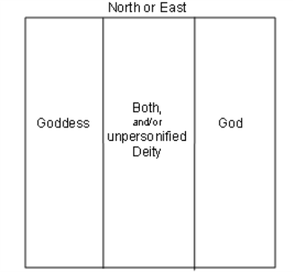 Generally, in sticking with a Wiccan **duo-theistic view, the altar is divided into three sections. The left side of the altar is dedicated to the female aspect of Deity, to one's Goddess of choice; the right side of the altar is dedicated to the male aspect of Deity, to one's God of choice; and the center of the altar is dedicated to both aspects and/or to unpersonified Deity, that is an All, to every aspect of Deity as joined to be Ultimate Reality. Also, it is most common to face an altar to the North, the physical realm, or to the East, the realm of beginnings. It is important to note that though the altar is "facing" that direction, it is the back of the altar that is truly closest to that direction. In standing before your altar, you are the one, then, who is facing that direction. 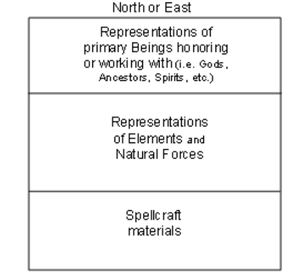 At the back of the altar is where things like Deity statues or candles go. Behind these, you can place decorations or some sort of display for the rite or ceremony, e.g a May Gad for a Beltain Rite or a Scrying Mirror for a Full Moon Rite. In the middle section of the altar is where Elemental representations go. This is most commonly in the form of your working tools, such as athame, wand, chalice, and pentacle. The front of the altar holds the materials for any magickal workings that will be taking place. This includes things like a cauldron, mortar and pestle, incense, and candles. Keeping these layout guidelines in mind, there is actually a lot of leniency in setting up an altar. It is important to remember, though, that there should be nothing placed upon your altar that is without meaning. Remember: an altar is a sacred place, do not desecrate it with mundane items like your cell phone or soda can. So, in the spirit of leniency and freedom of expression and in honor of your own unique path and relationship with your Gods, here are a few examples of altar layouts. 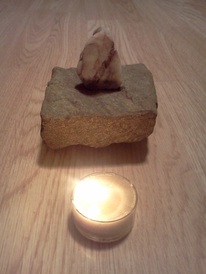 Simple Altar Simple Altar This is a very basic altar set up. Despite its simplicity and inconspicuous nature, there is actually much meaning here. I used this small altar for several months when I had no space or ability to have anything larger. This sat atop my dresser and I used it daily for meditation, communion with my Gods, and spell work. Both stones were found on my family's land. The square stone brings to mind the physical world, it has four sides and it is very stable; it gives a good grounding. The Snow Quartz has a band of Granite running through it. In using this stone as representation of Deity, the band represents an imminent Divine and that though the Divine is responsible for all, I would not be here were it not for my family (who themselves are a manifestation of Deity.) 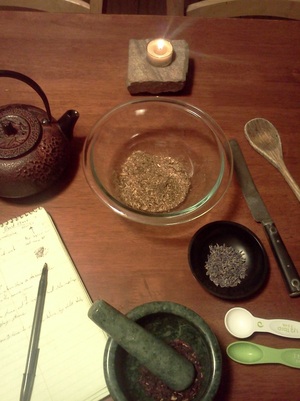 Kitchen Witch Altar Kitchen Witch Altar This type of altar set up is one that is familiar to any Kitchen Witch. Notice how all of the tools are common kitchen items? In fact, even the altar itself is nothing more than a kitchen table. And what is a wooden spoon but the wand of the kitchen? What is a teapot but a variation of a cauldron? Were it not for the simple candle lit at the back (and the presence of the black handled knife, when there's nothing but herbs here...) there's nothing that unusual here; it could be the kitchen table of anyone with at least a budding interest in herbs. This is, of course, not a permanent altar. An altar can be set up whenever you have need using whatever you have on hand. This altar exists only so long as the need is there and there is work to be done. There is no distinction between magick and living, except that which we create in our own minds. 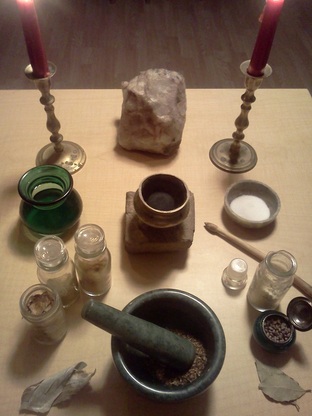 Altar set up for a Spell Altar set up for a Spell This set up is a little more formal, with candles lit for a Goddess and a God, and dishes of water and salt. A large, rough crystal sits at the back of the altar, middle is filled with tools, and the front is littered with spell materials, primarily containers of various herb matter. Still, there is nothing on this altar without meaning or purpose. The red candles imply that the magick being wrought is of a protective nature. Given that this spell utilizes a small cauldron and charcoal briquette (upon which to smolder the ground herbs) this makes sense. The entire set up is evocative of Fire. With this in mind, the water and salt dishes may seem out of place, but both are used in casting a Circle, which only lends further evidence for the protection being sought with this magickal working. And in considering the presence of the Deity candles, one can surmise that this is especially strong protection desired. 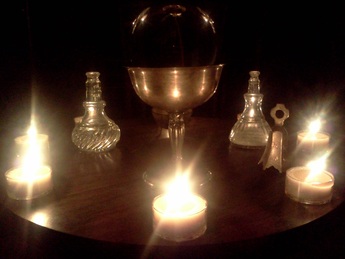 Full Moon Altar Full Moon Altar This is an example a Full Moon altar where scrying is to be done. This altar features a silver chalice at center, representative of Lunar Goddesses; a crystal sphere rests inside, reflecting the gentle light of the candles. At the back of this altar is a censor (hidden by chalice.) Smoldering incense aids in altering states of mind and conveying intentions to other realms. A small bell sits to the right, representing Air and the masculine, it's gold color compliments the silver chalice. Though this altar is set up for a Full Moon rite, there are eight candles at the edge of the altar representing the Sabbats. As the Full Moon is a key point in the Lunar cycle, the Sabbats are key points in the Solar cycle. This further inclusion of Solar symbolism fosters balance and places emphasis on the connection shared between all. *An altar is a dedicated space to your interaction with your Gods, a shrine is a dedicated space to your Gods’ presence. **Duotheistic means two Deities; dualistic is part of worldview. Dualism states that there are two: this and that, black and white, good and bad. Wicca does not have a dualistic worldview: the Wiccan worldview focuses upon the connection between all and the resulting energetic interplay. There is no dualism within Wicca. The God and Goddess are not dualistic: They compliment eachother but They are not opposites. Other Articles You May Like: Altars Sacred Space Magick and the Mundane Magickal Symbolism: Fertility Unveiled Comments are closed.
|
|
